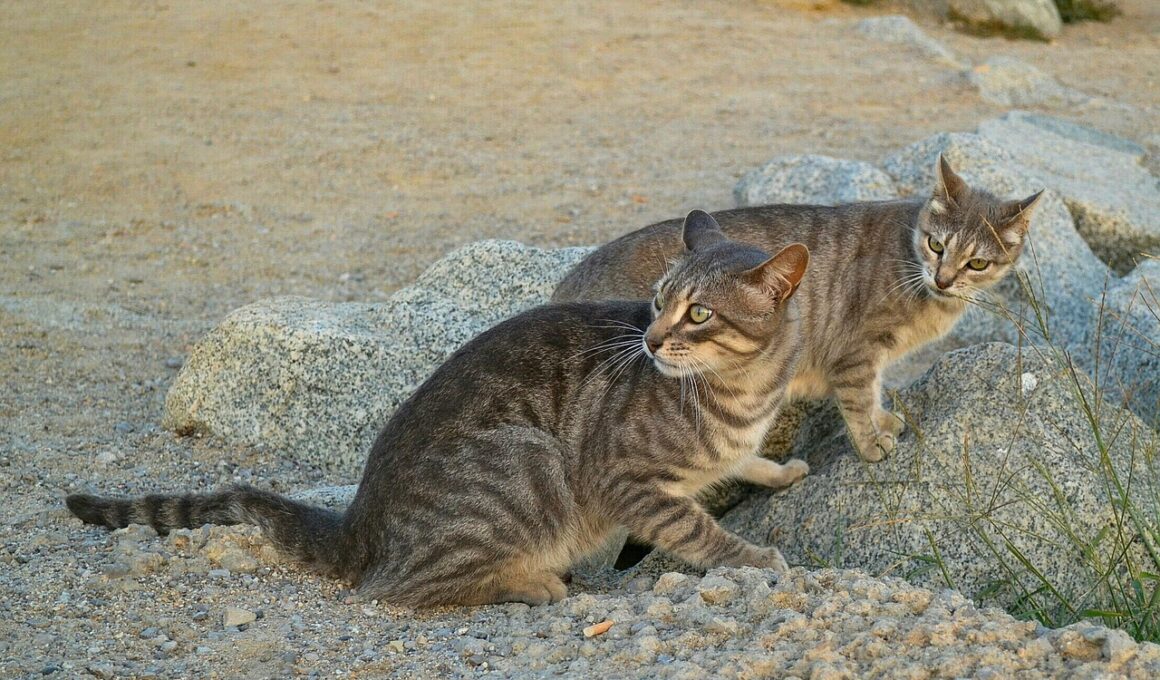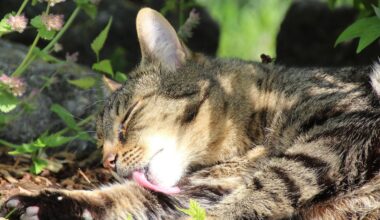The Impact of Endangered Species Laws on Feral Cat Populations
Feral cats are often at the center of heated debates, primarily due to their impact on local wildlife and the legal frameworks that govern their management. The interplay between feral cat populations and endangered species laws introduces complex challenges for policymakers and conservation advocates. Such laws, designed to protect native species, can inadvertently lead to stringent measures against feral cat management. Environmentalists argue that feral cats significantly threaten the survival of vulnerable wildlife. Critics contend that overly aggressive regulations can demonize feral cats, placing their welfare and management at risk. Mitigating this tension requires a careful consideration of both ecological balance and legal constraints. Lawmakers face the difficult task of reconciling regulations that seek to protect endangered species while addressing the realities of feral cat populations. Educational campaigns promoting responsible cat ownership and community-based management strategies could potentially provide pathways toward resolution. While strong laws protect endangered wildlife, they can also create a legal minefield for cat welfare advocates. The key lies in developing comprehensive solutions that encompass both biodiversity protection and humane treatment of feral cats. Establishing a balanced narrative is essential for fostering understanding and innovative solutions.
The extent of environmental impact caused by feral cat populations leads to necessary legal considerations around their management. Listing a species as endangered often triggers specific protection mechanisms that can constrain feral cats’ management practices. When protected species overlap in habitat with feral colonies, the consequences can range from lethal control strategies to relocation attempts. These methods frequently ignite controversy among animal rights advocates as well as community members. Solutions focusing on Trap-Neuter-Return (TNR) programs offer a feasible solution that respects both animal rights and the protection of native species. Some studies indicate that TNR can stabilize feral populations and minimize their predation on endangered species by controlling reproduction. However, implementation of TNR programs is often obstructed by legal restrictions tied to endangered species conservation. Balancing the needs of communities, feral cats, and endangered species requires interdisciplinary efforts and cooperative governance. Fostering dialogue between conservationists, feral cat advocates, and local authorities is crucial for developing and implementing effective policies. Legal frameworks must evolve to embrace humane and sustainable methods for managing feral cat populations while ensuring the safety of vulnerable wildlife.
Legal Frameworks and Their Challenges
Legal frameworks governing feral cats and endangered species often reveal systemic challenges in practical implementation. These laws can create unintended consequences, complicating local management efforts and creating hostility between stakeholders. For instance, certain regions may impose strict penalties for the management of feral cats, making it difficult for organizations to conduct humane interventions. The legal tension becomes evident when feral cats are deemed both harmful to endangered birds and yet not prioritized for humane treatment. Educating municipal leaders on the significance of TNR programs, as well as the consequences of legislative overreach regarding feral cat welfare, is essential. Coordinated efforts that align legal frameworks with effective management practices can lead to sustainable solutions. Developing new ordinances or revising existing laws might empower communities to carry out humane population control without jeopardizing vulnerable wildlife habitats. Stakeholder collaboration is key, as establishing common ground facilitates the development of effective strategies. Lawmakers can benefit from evidence-based approaches, thereby ensuring balanced alternatives are available for feral cat management while complying with necessary conservation efforts. Constructive engagement can ultimately yield better legal frameworks that meet both environmental and animal welfare goals.
Feral cat populations often exist in complex social dynamics that intermingle with local wildlife conservation efforts. As such, the dialogue around feral cats provokes strong emotional responses from various communities. The connection between feral cats and endangered species also raises questions about the ethical implications of different management strategies. Some advocates argue that all measures should prioritize humane treatment of animals, while others emphasize the need for strict conservation actions to protect vulnerable biodiversity. This ethical dilemma places policymakers in a precarious position, where community preferences and ecological responsibilities collide. As public perceptions change regarding feral cats, legislation must adapt to reflect evolving attitudes and scientific understanding. Increasing support for collaborative management initiatives might offer a transformative solution that encompasses community engagement and ecological justice. By promoting awareness of the social and ecological factors involved, stakeholders can shift the narrative surrounding feral cats towards more inclusive approaches. Addressing compassionate concerns alongside ecological considerations will foster a dialogue that respects all stakeholders while maintaining focus on preservation goals. Only by actively listening and working together can tangible improvements occur for both feral cats and endangered wildlife.
Future Directions for Management
Looking ahead, the interplay between feral cats and endangered species laws suggests the necessity of innovative management solutions. Enhanced public awareness campaigns can play a crucial role in bridging the gap between conservation and the local community. By fostering a culture of responsible pet ownership and community-led interventions, society can empower individuals to take part in managing feral cat populations. Local governments may also explore partnerships with wildlife agencies and conservation organizations. Such collaborations can create holistic approaches to population management that align with both ecological goals and animal welfare principles. Exploring adaptive management strategies that incorporate scientific research and community feedback could yield promising outcomes. This would necessitate regular evaluations of program effectiveness, ensuring continuous improvement while adhering to legal frameworks. The political landscape surrounding feral cat regulations is likely to evolve in response to increasing awareness and advocacy efforts. Engaging citizens through educational programs can cultivate stronger connections to local wildlife and the ecosystem. As society adapts to the challenges of biodiversity conservation and humane animal management, better solutions can emerge that serve both feral cats and endangered species.
Moreover, fostering collaborations across multiple stakeholders offers invaluable perspectives that can enhance legal compliance and community engagement. Stakeholders must include animal welfare organizations, conservation groups, and local governments in discussions centered on feral cat management. A unified strategy, informed by stakeholders’ diverse experiences, will result in more successful policy implementations. As negotiations progress, transparent communication within community dialogues is essential. Policies informed by local insights not only create resilience but can also reflect the values of the broader community. As these legal conversations unfold, the growing emphasis on compassionate management rather than punitive measures may reshape the narrative around feral cats. Re-evaluating metrics for success, beyond mere population control, is vital to achieve lasting change. Such measures include the health of ecosystems and the well-being of both humans and animals within the community. Therefore, a commitment to continuous learning and adaptation, supported by sound legal practices, can lead to transformative results. Ultimately, the synergy between informed legislation and compassionate outreach forms the foundation for effective feral cat management that simultaneously protects endangered species.
Conclusion: Toward Harmonious Coexistence
In conclusion, addressing the impact of endangered species laws on feral cat populations requires nuanced understanding and collaborative efforts among all stakeholders. These complex interactions between legislative processes and ecological needs necessitate an agile approach to management. Moving forward, innovative solutions that harmonize the needs of communities, feral cat populations, and endangered wildlife are essential. Establishing inclusive discussions can lead to effective programs that encourage responsible ownership and proactive engagement in local wildlife conservation. The following steps might aid in fostering positive community outcomes and wildlife welfare: investing in educational initiatives, advocating for humane management practices, and creating supportive policy frameworks. As feral cats exist as part of ecosystems, their management cannot be conducted in isolation from broader conservation goals. Therefore, increased collaboration among stakeholders can help facilitate humane solutions that respect the importance of biodiversity. Only by bridging divides and prioritizing dialogue can solutions emerge that promote harmony between feral cats and endangered species. The legal and ethical dimensions of managing these populations represent an ongoing challenge that calls for continued vigilance and cooperation within communities to ensure sustainable outcomes.
To achieve lasting impacts, the convergence of feral cat welfare, community interests, and environmental conservation is imperative. Building alliances between organizations committed to both animal rights and biodiversity will play a significant role in shaping future legislation and management practices. As successes in humane and effective feral cat management are documented, backup data will serve to gradually shift public opinion and influence policies. An educated and engaged populace can advocate for interventions aligned with conservation objectives, promoting actions that uphold ethical standards. Moreover, as urgent ecological issues escalate due to climate change, we must emphasize the interconnectedness of all species and ecosystems. Through educational efforts, fostering empathy towards feral cats can lead to progressive changes in local legislative environments. Legislative recommendations should stem from comprehensive research, reflecting best practices derived from real-world applications. Expanding community involvement in decision-making processes can enhance local governance and increase compliance with feral cat management initiatives. By advancing collaborative management approaches, societies can ensure that both feral cats and endangered species thrive within their own habitats. To this end, novel pathways forward can pave the way for resilient ecological communities that prioritize coexistence and humane treatment.


